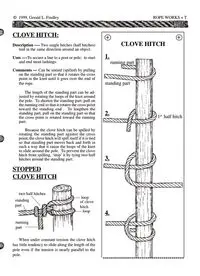
Clove Hitch 2004 PDF
Preview Clove Hitch 2004
© 1999, Gerald L. Findley ROPE WORKS + T CLOVE HITCH: Description —- Two single hitches (half hitches) tied in the same direction around an object. Uses —-To secure a line to a post or pole; to start and end most lashings. Comments — Can be untied (spilled) by pulling on the standing part so that it rotates the cross point in the knot until it goes over the end of the rope. The length of the standing part can be ad- justed by rotating the loops of the knot around the pole. To shorten the standing part, pull on the running end so that it rotates the cross point toward the standing end . To lengthen the standing part, pull on the standing part so that the cross point is rotated toward the running part. Because the clove hitch can be spilled by rotating the standing part against the cross point, the clove hitch will spill itself if it is tied so that standing part moves back and forth in such a way that it cause the loops of the knot to slide around the pole. To prevent the clove hitch from spilling, ‘stop’ it by tying two half hitches around the standing part. + + CLOVE HITCH 2. 4. 3. standing part running part 1. 1st half hitch When under constant tension the clove hitch has little tendency to slide along the length of the pole even if the tension is nearly parallel to the pole. ---------------------------------------- ----- loop ----- loop of clove hitch two half hitches --------- running part --------- standing part ---- STOPPED CLOVE HITCH © 1999, Gerald L. Findley ROPE WORKS + T + + 5. 6. 8. 2nd half hitch running part standing part 7. (front) pull tight <-------- (back) ---------> pull tight Narrative ---- (For clove hitch knotboard.) (1) Start the clove hitch by taking a bight around an object with the running part. (2) Cross the running part over the standing part to form a half hitch. (3) Start the second half hitch by continuing to wrap the standing part around the object in the same direction as the first half hitch. (4) Form a second bight around the ob- ject. (5) Finish the second half hitch. (6)&(7) Grasp the standing part and the running part: pull tight the clove hitch tight. ---------------------------------------- (1) Form two underhand loops in the running part of the rope. (4) Pull tight. (3) Drop the loops over the end of the pole. (2) Place the right under- hand loop on top of the left underhand loop. CLOVE HITCH; OVER AN END: A clove hitch can be tied over the end of a pole or stake by using this method.
